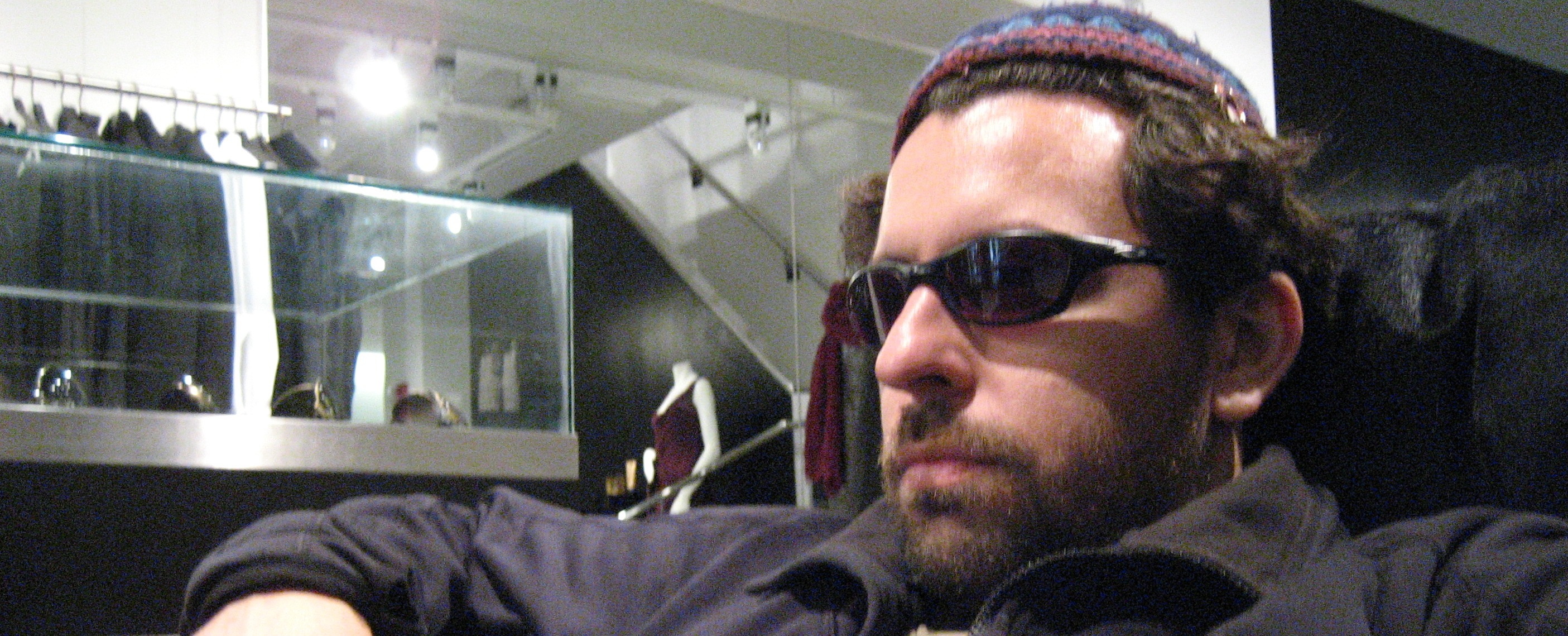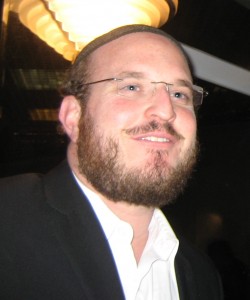Shlomo Katz: Filling his world
An eventful year has ended with a new album for singer/songwriter Shlomo Katz.
click here for original post
BY Amihai Zippor
For Jerusalem-based Shlomo Katz, this could not have been a more eventful year. Finding a wife, releasing his second solo album, and with a project aimed at archiving the teachings of the late Rabbi Shlomo Carlebach moving forward, the 28-year-old singer/songwriter of Jewish hassidic/folk/rock feels he is entering a new stage.
Born in New Jersey, Katz and his family moved to Los Angeles when he was three and then to Israel when he was nine. It was during a high-school recess in Ra’anana that he experienced a crucial moment that introduced him to Carlebach. A new student enrolled in the school was an only child from a divorced family. During class breaks instead of playing ball with the group, he sat on the sideline listening to his Walkman. Intrigued, Katz approached the student and asked him what he was listening to.
“It was like right out of a movie,” Katz recalls. The young boy gently took off his headphones and handed them to Katz. “I’ll never forget that moment for the rest of my life when he placed the headphones on my ears and I heard Reb Shlomo Carlebach singing. It was a haunting moment, a haunting voice, and all I could think inside was that I needed a lot more of it. I felt like everyone does when they hear it – that it’s only for me, and I also felt like I could never get enough of it.”
The two became friends, and Katz borrowed many recordings of Carlebach’s songs and stories. A year later his family moved again, but this time back to LA where his father took the position of cantor at Temple Beth Jacob Synagogue of Beverly Hills. Although Carlebach died in 1994, his legacy spread across the globe and at Beth Jacob, many of his longtime followers formed what became known as the Happy Minyan in the downstairs hall. While Katz’s father was leading the services upstairs, Katz was reading the Torah, leading services and teaching downstairs.
“At 16, I arrived in LA on fire for what I had tasted in terms of my being exposed to the world of Reb Shlomo Carlebach, and at the time nothing could have fulfilled that more. Once in LA I was spending personal time with many people who were close to him over the years. I jumped from just getting glimpses of his light through his voice on audio to firsthand stories and experiences from people that I became very close friends with, including the Carlebach family,” says Katz.
On a trip to Israel a year later for the anniversary of Carlebach’s death, Katz fell ill and wasn’t able to leave the home of Susan Kates, his mother’s childhood friend. A singer/songwriter herself, Kates was also a longtime admirer of Carlebach. As he was recovering, she showed Katz a few chords on the guitar and how to play one of Carlebach’s melodies.
“I grew up in a musical house with my father playing piano, accordion, being a cantor and also composing his own music. We also had an eclectic music collection with names such as The Beatles, Yanni, Ofra Haza, Esther Ofarim, Safam and Avraham Fried. However, the feeling I could play one of Reb Shlomo’s nigunim with these two chords blew me away. I played violin from age three to 11, yet I never even thought of guitar. When I realized how simple it was, I bought one before I left Israel for NIS 200,” he says.
Although having never personally met Shlomo Carlebach, Katz found himself traveling America strengthening Jews in the spirit of his non-present mentor. In the course of four months, Katz continued learning and flowing with Carlebach’s music, giving classes to people in synagogues, colleges and rehab centers, but it was mainly teaching with brushes of guitar.
“You see, in the years after Reb Shlomo passed away, something happened in the world and something happened in our home,” he explains. “At the time, it was all beyond me, and I didn’t know how to handle it because it seemed like so much came at such a young age. It was very overwhelming for me to realize how much it takes to touch people’s hearts.”
However, he eventfully found himself getting more into his own learning, and despite a possible music career in the US, he realized if he wanted to teach in the capacity he envisioned, he needed serious training in a rabbinical program. Also he strongly believed that if he really wanted to do what he was doing and make it last forever, he needed to return to Israel. As a result, he began searching on the Internet for a place to study there and found what was then Rabbi Chaim Brovender’s Yeshivat Hamivtar on the outskirts of Efrat. In 2002, at age 22, Katz packed his bags for the Holy Land, only taking his guitar after his father insisted.
“There were thoughts of going to the Old City, but I knew I needed some degree of quiet and had no intention of even bringing a guitar. My father convinced me that I should. He said, ‘Listen, people are going to call on you. You need to bring your guitar.’ I told him there are thousands of people that are doing this and doing it so much better than I am, and it’s not fulfilling my needs. He said, ‘Just take it’ – and I did.”
Katz had already made two albums of original music with his brother Eitan while he was in LA. By the time he returned to Israel, the second album, Biglal Avos, had been doing well enough in the Israeli-Anglo community that demand grew for Shlomo Katz to perform. His friends, specifically Petah Tikva guitarist/cantor Dvir Spiegel and Efrat drummer and childhood friend Eli Farkas, were also encouraging him to move forward with his musical career, despite his being at yeshiva full time. What began as small gigs in private homes spread to hour-long jams with friends and eventually weddings and invitations to play in yeshivot across Israel, venues where Katz says he finds his true language and expression as a musician.
Nevertheless, with the sudden opening toward a musical career in Israel, Katz also witnessed its taking a toll on his studies. He grappled with putting down his guitar permanently; but after much inner searching, the message was clear: He would strive for the balance between learning and sharing Carlebach’s music because the one apparent thing was that both were planting good seeds in the world. Part of the balance was also expressing himself through his own music, which at first he would play sparingly to crowds before realizing how much the audience wanted it. The result was the 2006 release of his first solo album, Ve’hakohanim. The work was widely received despite the fact that, as Katz puts it, “It was not a typical Jewish music album.”
Last month, Malei Olam, his second solo album, was officially released. While it is also not typical, it is a resonant representation of where Shlomo Katz is today. “I worked with Amit Golan, a very deep listener who produced the album and who put his heart and soul into the project, pushing me to believe we can create a meaningful recording,” says Katz. After he had he met Golan in a studio where Katz often worked doing vocal sessions for other musicians, the producer took him out to dinner and told him to take himself more seriously. “He told me to believe in myself much more. He pushed me to go into the studio,” says Katz.
Although the struggle between learning and making music continued, the payoff was that both matured. “I keep thinking that the resolution of my world will keep flowing with the time, that I just have to put my energy into the learning and the teaching, and the music will just come as is. But I see with everything in holiness, including music, you have to honor it,” he notes.
Malei Olam was actually completed a year ago, but in the interim Katz met his wife and got married. For a long time, the music was kept as a little gift, which he shared with his wife and his family. Although the album is a year old, Katz says he’s still connected to the same energy, even though his life has changed.
“There’s something so beautiful about listening to a new calling but not ignoring the past, and the combination of the two is something Reb Shlomo was able to master. He is my biggest influence in that area because he would always say, ‘You can cry for the past, but you have to fix the future.’ Right now I feel like I am in the middle of both of them.” That said, the new music is more melodic yet reminiscent of his earlier songs. The difference? “Musically you hear newness, a lot of fresh air and a lot of space,” says Katz. “The notes that aren’t played, and the places where you really hear the music breathing is much more evident in this album.”



